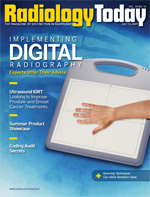 July 13, 2009
July 13, 2009
Digital Imaging and EHRs: Seeking Definition
By Jim Knaub
Radiology Today
Vol. 10 No. 13 P. 34
How will “meaningful use” be defined?
That answer is beginning to emerge and will prove important as hospitals and imaging facilities pursue funds that the Obama administration and Congress’ economic stimulus package has earmarked to support broader implementation of electronic health records (EHRs). The first draft of the definition appeared June 16 and included 22 objectives. Almost immediately after it was released, National Coordinator for Health IT David Blumenthal, MD, MPP, asked the policy committee work group to revise its initial recommendations. A summary of the initial definition is available at www.himss.org/advocacy/ContentRedirector.asp?ContentId=69361. Obtaining some of that funding was the topic of a well-attended session at the Society for Imaging Informatics in Medicine (SIIM) annual meeting in Charlotte, N.C., last month. The American Recovery and Reinvestment Act of 2009 allows for up to $44,000 in bonus payments to physicians who demonstrate meaningful EHR use by 2015.
While facilities have an obvious interest in obtaining some of those federal funds to defray the costs of implementing an EHR, the definition of meaningful is not yet known.
The session panelists—moderator Bradley J. Erickson, MD, PhD, FSIIM; Eliot L. Siegel, MD, FSIIM; and David S. Mendelson, MD—pointed out that privacy and interoperability will likely be key parts of the federal effort to expand EHRs and qualify for the earmarked money.
“I’m pretty sure you’re not going to collect your $44,000 per provider without the underpinnings of interoperability,” Mendelson, an associate professor of radiology at Mount Sinai Medical Center in New York City, told the audience.
First Step
What Mendelson calls the underpinnings of interoperability is a beginning, not an end point, for the goal. Don’t expect a broad, national interoperable network to be put in place in the next few years.
Personal privacy and security issues will also exert their influence on the EHR expansion process. HIPAA regulations apply to the information exchange that EHRs create. And as one panelist at the SIIM session pointed out, politics won’t permit creation of a national healthcare identification number that would simplify many aspects of building a national network of interoperable records systems. Privacy will be a factor, but its exact effect remains unclear.
Even when the final definition is released—and let us hope clearly understandable—healthcare organizations must still come up with the funding to implement their systems. The earmarked federal funds won’t be released up front to help purchase the systems, but they would be released beginning in 2011 when facilities have implemented electronic records and met the meaningful use criteria.
Creating a definition for meaningful use that triggers eligibility for federal funds makes sense to ensure the money is well spent. It also creates an interesting pressure on system vendors and those who make the purchasing decisions concerning EHR systems. Imagine the anger directed at the vendor who sells a system that ultimately fails to qualify for federal reimbursement. Even worse, imagine being the person who faces the hospital board to answer why the system he or she selected—and the hospital purchased—ultimately did not meet the meaningful use criteria and the hospital won’t be eligible to receive anticipated and budgeted federal funds.
Fortunately, radiology is somewhat ahead of the curve because its growing experience with PACS and RIS should position imaging well in its role of making images and RIS data available to an enterprisewide EHR. Also, radiology management probably won’t be in the position of making the EHR purchasing decision.
In another sense, radiology’s experience in sharing images and reports may create the opportunity for the specialty to be a leader in the move to an EHR. Radiology was a founding partner of the Integrating the Healthcare Enterprise initiative. Similarly, SIIM grew out of radiology and broadened its mission to reflect the transition to enterprise-level informatics in healthcare.
Exactly how imaging will fit into the EHR puzzle isn’t clear, but what does seem clear enough is that you can’t have the meaningful use of electronic records without incorporating images and RIS information. How imaging and EHRs will connect may start to unfold in the coming months, but real broad-based interoperability is a ways off.
— Jim Knaub is editor of Radiology Today.

